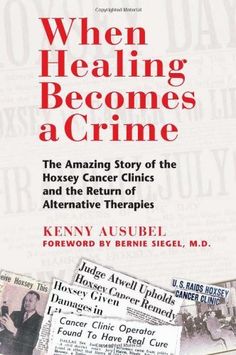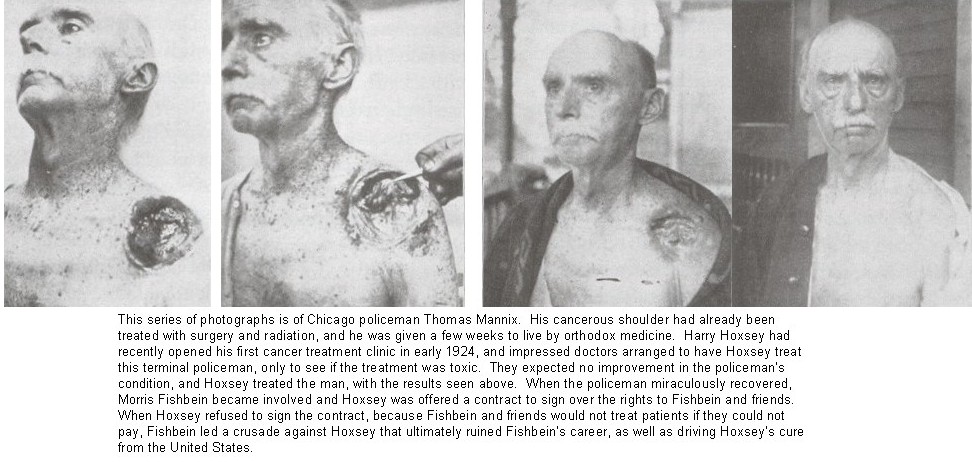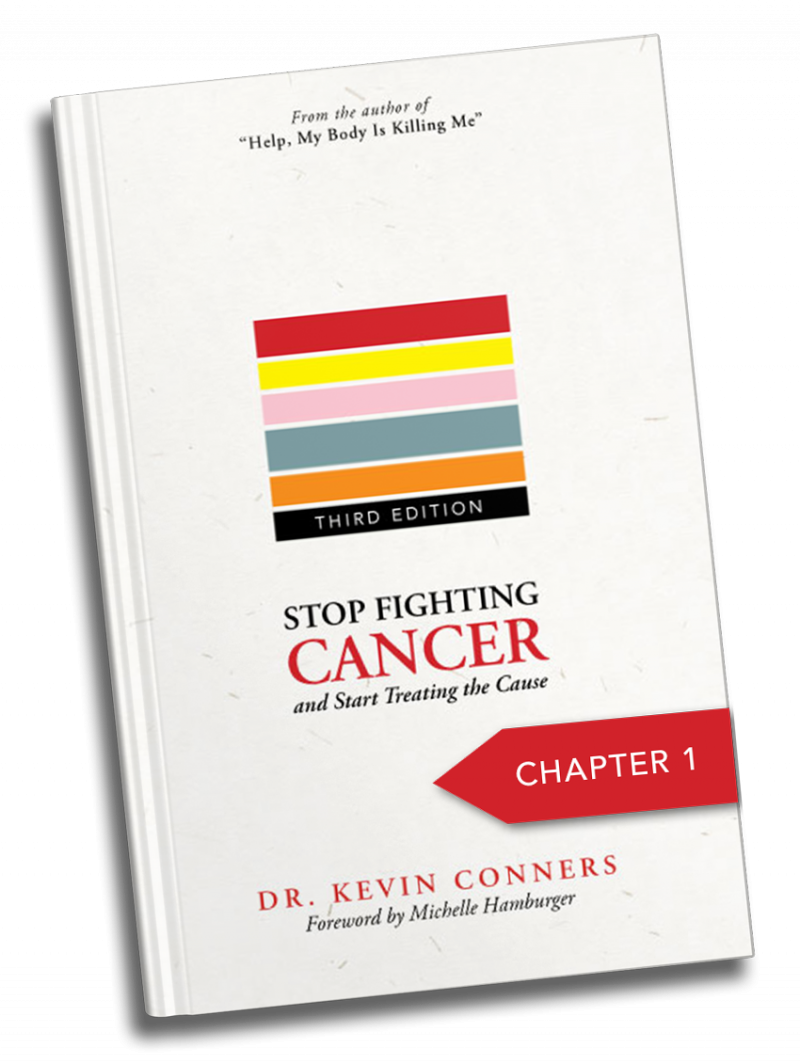Understanding Cancer and Hoxsey Therapy
Currently, this herbal approach to cancer therapy, involving an internal tonic, a topical salve, and a topical powder, can be obtained in its original form from Mexico. But for decades it was a thriving cancer therapy in the U.S. It was the first widely used non-toxic cancer approach, but was so heavily opposed by the American Medical Association that it was finally forced out of the United States in the 1950’s. Melanomas and lymphomas are considered the best responders to this herbal approach.
Hoxsey Therapy is a mixture of herbs, was first marketed as a purported cure for cancer in the 1920s by Harry Hoxsey, a former coal miner and insurance salesman, and Norman Baker, a radio personality. Hoxsey claimed that he traced the treatment to his great-grandfather, who observed a horse with a tumor on its leg cure itself by grazing upon wild plants growing in the meadow. John Hoxsey gathered these herbs and mixed them with old home remedies used for cancer. Among the claims made in his book, he purports his therapy aims to restore “physiological normalcy” to a disturbed metabolism throughout the body, with emphasis on purgation, to help carry away wastes from the tumors he believed his herbal mixtures caused to necrotize.

Over time, people sought out Hoxsey for the treatment of their cancer and he opened 17 clinics that he would eventually be closed by the FDA. Dogged in many states by legal trouble for practicing medicine without a license (he wasn’t a doctor), Hoxsey frequently shut down his clinics and reopened them in new locations. In 1936, Hoxsey opened a clinic in Texas which became one of the largest privately owned cancer centers in the world. At one point in the 1950s, Hoxsey’s gross annual income reached $1.5 million from the treatment of 8,000 patients. No one can doubt the success he had in treating cancer patients and he won the respect of several heavy critics after successfully treating their family members, but Hoxsey made some critical errors. His ego was his downfall. He claimed to ‘cure cancer’ and stuck to his statements of ‘cure’ despite what the AMA and FDA did to shut him up. He may have ‘cured’ many cancer patients but NO ONE can claim a ‘cure’ regardless of how a patient responds. Ego and pride is the downfall of many.
The truth: The Hoxsey formula is a great detoxification tool which we make good use of with many of our patients. One does not need to go to Mexico to utilize Hoxsey protocols.
Harry Hoxsey – the TRUTH
Hoxsey was as Illinois coal miner before he began to promote himself as a healer in the 1920s. He was a dynamic salesman, which did not bode well with medical contemporaries. Hoxsey mixed his claims with flamboyant public statements that skillfully contrasted his populist heritage with the growing elitism of the American medical profession.
In common with many advocates of unconventional therapies, Hoxsey considered cancer a systemic disease, however localized its manifestations might appear to be. Hence his therapy aimed to restore physiological normalcy to a disturbed metabolism throughout the body. With an emphasis on detoxification, Hoxsey believed his herbal formula would aide the body to carry away wastes from the tumors he believed his herbal mixtures also caused to necrotize (Hoxsey, 1956, 44-48, 60).
Hoxsey treated external cancers with considerable success using an herbal paste containing antimony sulfide, bloodroot (Sanguinaria canadensis) and zinc chloride. He also used a yellow powder containing arsenic and antimony sulfides, various plant substances, talc, and what Hoxsey called yellow precipitate (JAMA, 1951, 253; Hoxsey, 1956, 47).
While we KNOW better today and have omitted the toxic metals that Hoxsey used in his pastes, one cannot deny the success he achieved.
In 1941 Frederick Mohs, a respected surgeon in Madison, Wisconsin, with the help of the Dean of the University of Wisconsin Medical School and several of its faculty, devised a method of surgically removing accessible cancers under complete microscopic control (Mohs, 1941). The substance which Dr. Mohs and his co-workers created for fixing the suspected tissue in situ, to enable him to excise it layer by microscopic layer, contained the same ingredients as Hoxsey’s red paste. Dr. Mohs published his new method in 1941 in the ultra-respectable Archives of Surgery and in 1948 in JAMA (for later refinements, see Mohs, 1956; Phelan 1962, 1963a, and 1963b).
Nonetheless AMA spokesmen, during their accelerated onslaught on Hoxsey in the 40s and 50s, discounted the fact that Mohs paste and Hoxsey’s were identical. In condemning caustic pastes as one type of frauds and fables in 1949, the AMA implied that arsenic was the chief ingredient of Hoxsey’s paste (which was a lie), on the basis of their own testing of a sample pirated in the 20s (JAMA, 1926, 57; Young, 1967, 365).
Apparently Mohs use of surgery (which, along with radiation, constituted the entire range of what the Council considered established treatment) made his method, in contrast to Hoxseys, scientific and acceptable. The Council failed to grasp the central fact that both men were using sanguinarine, an alkaloid of bloodroot which has potent antitumor properties described in the medical literature as early as 1829 (Young, 1967, 365; Hartwell, 1960, 23-24).
Currently, Mohs surgery is still being used – MINUS the paste! Sadly, it was the paste that made it effective!!!
The most controversial aspect of Hoxsey’s method, in the eyes of orthodox medicine, was the dark brown liquid, which he used to treat internal cancer. For many years Hoxsey refused to divulge the formula for this substance, generating a frenzy of vituperation in the pages of JAMA over a period of decades.
He later gave several differing accounts of its origin (Young, 1967, 362). According to his autobiography (Hoxsey, 1956, 62-64), it was his great-grandfather, a horse breeder named John Hoxsey, who developed it at mid-nineteenth century, out of grasses and flowering wild plants which John took from the pasture where a favorite stallion, afflicted with a cancerous growth, grazed daily until the growth necrotized. According to Harry, John Hoxsey reasoned that the wild plants had caused the stallions recovery. He therefore concocted a liquid out of red clover and alfalfa, buckthorn and prickly ash (and other plants which John could not identify), gathered from the area where the stallion had apparently cured himself.
 By 1950, court decisions had changed the labeling requirements forcing Hoxsey to divulge his ingredients on interstate shipments. In the ensuing litigation, Hoxsey revealed the composition of his long-secret preparation. He explained that, depending on the type and stage of cancer, and the individual patients condition, he added to a basic solution of cascara (Rhamnus purshiana) and potassium iodide one or more of the following plant substances: poke root (Phytolacca americana); burdock root (Arctium lappa); barberry or berberis root (Berberis vulgaris); buckthorn bark (Rhamnus frangula); Stillingia root (Stillingia sylvatica); and prickly ash bark (Zanthoxylum americanum) (Young, 1967, 375; Hoxsey, 1956, 45-46; JAMA, 1951, 252; JAMA, 1954, 667; Farnsworth, 1988).
By 1950, court decisions had changed the labeling requirements forcing Hoxsey to divulge his ingredients on interstate shipments. In the ensuing litigation, Hoxsey revealed the composition of his long-secret preparation. He explained that, depending on the type and stage of cancer, and the individual patients condition, he added to a basic solution of cascara (Rhamnus purshiana) and potassium iodide one or more of the following plant substances: poke root (Phytolacca americana); burdock root (Arctium lappa); barberry or berberis root (Berberis vulgaris); buckthorn bark (Rhamnus frangula); Stillingia root (Stillingia sylvatica); and prickly ash bark (Zanthoxylum americanum) (Young, 1967, 375; Hoxsey, 1956, 45-46; JAMA, 1951, 252; JAMA, 1954, 667; Farnsworth, 1988).
For all that the AMA and the FDA had been trying to force this revelation from Hoxsey for more than a quarter-century, they did not respond to it by investigating these botanical constituents for possible pharmacological properties. Instead, the AMA Bureau of Investigation dismissed the entire formula as worthless: only potassium iodide has any recognized therapeutic activity.
More recent literature leaves no doubt that Hoxsey’s formula, does indeed contain many plant substances of marked therapeutic activity. In fact, orthodox scientific research has by now identified antitumor activity of one sort or another in all but three of Hoxsey’s plants and two of these three are purgatives, one of them (Rhamnus purshiana) containing the anthraquinone glycoside structure now recognized as predictive of antitumor properties (Kupchan, 1976).
Between 1964 and 1968 four articles appeared in Lancet, Pediatrics, and Nature, describing the mitogenic activity of pokeweed, which triggers the immune system by increasing the number of lymphocytes, causing the formation of plasma cells, and elevating levels of immunoglobulin G (Farnes, 1964; Barker, 1965; Barker, 1966; Downing, 1968).
 In 1966 two Hungarian scientists, engaged in a screening program at the University of Szeged, published their findings of considerable antitumor activity in a purified fraction of burdock, a plant which they included in their project because of its use as a folk remedy for new growths and ulcerations (Dombradi, 1966). In 1972 Kupchan described the growth-inhibiting activity of sesquiterpene lactones, a structural group that includes burdock (Kupchan, 1972). In 1984 researchers at Nagoya University, Japan, found in burdock a new type of desmutagen; a substance uniquely capable of reducing mutagenicity both in the absence and in the presence of metabolic activation. So important is this new property that these scientists named it the B-factor, for burdock factor (Morita et al., 1984).
In 1966 two Hungarian scientists, engaged in a screening program at the University of Szeged, published their findings of considerable antitumor activity in a purified fraction of burdock, a plant which they included in their project because of its use as a folk remedy for new growths and ulcerations (Dombradi, 1966). In 1972 Kupchan described the growth-inhibiting activity of sesquiterpene lactones, a structural group that includes burdock (Kupchan, 1972). In 1984 researchers at Nagoya University, Japan, found in burdock a new type of desmutagen; a substance uniquely capable of reducing mutagenicity both in the absence and in the presence of metabolic activation. So important is this new property that these scientists named it the B-factor, for burdock factor (Morita et al., 1984).
Two recent studies from the Orient, one Japanese, one Chinese, have established the presence of antitumor substances in barberry (which Hoxsey also sometimes called berberis root). Testing tumor size in mice by the total packed cell volume method, Hoshi and his co-workers found strong antitumor activity in berberrubine, an alkaloid isolated from Berberis vulgaris (Hoshi, 1976). Also in 1976, Owen et al. derived from berberine a new antitumor substance which they have named Lycobetaine (Owen, 1976).
At the University of Virginia in the mid-70s, Kupchan and Karim isolated an antileukemic principle from buckthorn (Rhamnus frangula). Their discovery that the efficacy of this substance in leukemia is vehicle-dependent led these scientists to advise re-testing of other anthraquinone plant substances for similar antitumor activity (Kupchan, 1976).
It is sorrowful in the very least, maybe criminal, that the pharmaceutical company controlled AMA has disparaged ancient healing methods to control a market for financial gain. Think of the millions of lives lost due to corporate greed and Nazi-like brainwashing of fearful patients.
It is always painful to swim against the flow!



 In this Brand New 3rd Edition Dr. Kevin Conners adds almost DOUBLE the content with all new insights and practical tips on how to understand your body’s ability to heal and get back to a state of health.
In this Brand New 3rd Edition Dr. Kevin Conners adds almost DOUBLE the content with all new insights and practical tips on how to understand your body’s ability to heal and get back to a state of health.